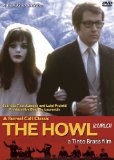Cult Epics continues its love affair with director Tinto Brass, and here once again delves into one of his early works. For my money, for all that his later erotica is handsomely shot and produced, what I’m seeing of his 1960s output (so far Deadly Sweet and this) is far more interesting. If 1967’s Deadly Sweet was demented, it at least followed a semi-recognizable mystery plot. The Howl (1969), on the other hand, defies description. It is basically a surreal picaresque, as a young woman (Tina Aumont) flees her wedding with a stranger (Luigi Proietti) who gives her a come-hither look. Already, this sounds far more sensible than the film really is. The couple race from one lunatic encounter to the next: a resort hotel apparently designed by Sade; a naked, cannibalistic philosopher and his family, and on we go.
What does any of this mean? Well, it’s all to do with youth revolution and breaking free of oppressive social and sexual mores, or something like that. Clearly heavily influenced by Godard’s Week-End (1967), it is much bouncier than its model and much zippier (picture Week-End directed by the Monty Python crew, and you have the idea), but it is also less rigorous. Naïve and wildly imaginative, pretentious but never dull, and bursting with a rambunctious love of its medium, this is a film that I feel very kindly disposed toward, yet I can also completely understand why others would hate it. According to the jacket copy, Brass turned down an offer to direct A Clockwork Orange in order to make The Howl. While I am hugely relieved he didn’t do the former, I am also quite glad that he made the latter.
Video
The film ran into all sorts of censorship problems, and this is the uncut version, taken from Brass’s own print. That the film is intact is wonderful. The print itself, though, is looking a bit raw in spots, with some pretty severe grain, scratches and other forms of damage. I have to confess that the rough-around-the-edges look rather adds to the film’s period charm, but videophiles should be aware of the limitations here. At times the softness of the image almost looks like the transfer came from a VHS source, though I don’t think that’s the case. Now, Brass is constantly playing with the physical medium of film, shifting from colour to black-and-white, but some of the damage I’m seeing can’t, I don’t think, be attributed to artistic intention.
Audio
The film’s age is showing here, too, especially in the early goings, when the background hiss is severe, almost as loud as the dialogue. Things get better later, and the mono is otherwise decently clear.
Commentary Track: In his review (http://www.shockcinemamagazine.com/tinto.html) of the film, seen in a theatre without the benefit of subtitles, Steven Puchalski of Shock Cinema doubts the film would have made much more sense if Brass himself had been sitting next to him, explaining every frame. Well, here’s the chance to put that theory to the test, and we have Brass doing just that. Turns out Puchalski isn’t far off the mark. Brass does clarify his intentions, explains metaphors and the like, but also admits that the film, shot in 1968, was made up as they went along, reflecting the filmmakers’ day-to-day reactions to the tumultuous events of that year. Furthermore, Brass maddeningly doesn’t address some obvious questions, such as why, exactly, he felt it necessary to decapitate a duck.
Special Features
Photo Gallery: Emphasizing the nudity in the film.
Trailers: For Brass’s Attraction and Deadly Sweet..
Final Thoughts
The film is completely demented, and a bit of a mess. How delightful!






